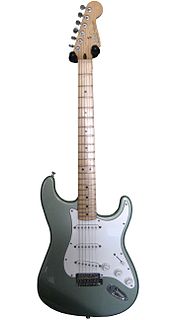
The Fender Stratocaster, colloquially known as the Strat, is a model of electric guitar designed from 1952 into 1954 by Leo Fender, Bill Carson, George Fullerton, and Freddie Tavares. The Fender Musical Instruments Corporation has continuously manufactured the Stratocaster since 1954. It is a double-cutaway guitar, with an extended top "horn" shape for balance. Along with the Gibson Les Paul, Gibson SG, and Fender Telecaster, it is one of the most-often emulated electric guitar shapes. "Stratocaster" and "Strat" are trademark terms belonging to Fender. Guitars that duplicate the Stratocaster by other manufacturers are sometimes called S-Type or ST-type guitars.
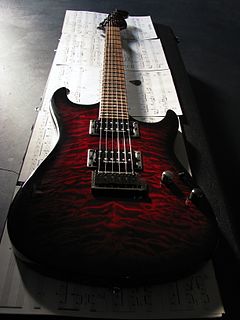
The Fender Showmaster is a discontinued model of electric guitar made by Fender, and is characteristic of a superstrat. Also see the badge change of Stagemaster due to legal reasons.
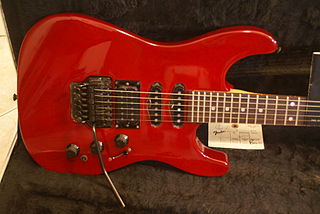
Superstrat is a name for an electric guitar design that resembles a Fender Stratocaster but with differences that clearly distinguish it from a standard Stratocaster, usually to cater to a different playing style. Differences typically include more pointed, aggressive-looking body and neck shapes, different woods, increased cutaways to facilitate access to the higher frets, increased number of frets, contoured heel facilitating easier higher fret access, usage of humbucking pickups and locking vibrato systems, most commonly the Floyd Rose.

The Fender Telecaster Deluxe is a solid-body electric guitar originally produced from 1972 to 1981, and re-issued by Fender multiple times starting in 2004.

Charvel is a brand of electric guitars founded in the 1970s by Wayne Charvel in Azusa, California and originally headquartered in Glendora, California. Since 2002, Charvel has been under the ownership of Fender Musical Instruments Corporation.
The Jackson Soloist is an electric guitar model manufactured by Jackson Guitars that was officially produced since 1984. The design is a typical "superstrat" with differences from the Stratocaster being a: neck-thru design and often a Floyd Rose or a similar tremolo, premium woods, a deeper cutaway at the lower horn for improved access to the higher frets, and a sharper body with squared off edges.
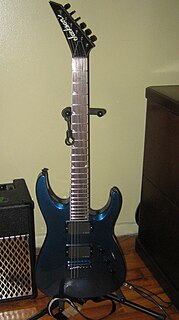
The Jackson Dinky is a Superstrat-style double-cutaway electric guitar built by Jackson Guitars. The "Dinky" is named for its slightly smaller than normal (7/8) body size. Usually fitted with a two humbucker pickup configuration, some models also include single-coil pickups and/or just one bridge humbucker. The fretboard can be made out of ebony, rosewood and more recently maple, or rock maple, with 24 jumbo frets and is always built with a bolt-on neck. Most of the guitars have a Floyd Rose original or licensed tremolo, and a locking nut to help maintain stable tuning. Some Dinkys have hardtail, or String-Thru bridges. The Jackson Dinky is usually preferred by players of hard rock and heavy metal.
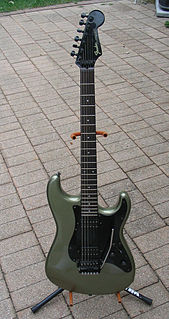
Fender Contemporary Stratocaster electric guitars were produced by Fender Japan in the 1980s.
The Fender Bullet was an electric guitar originally designed by John Page and manufactured and marketed by the Fender Musical Instruments Corporation. It was first introduced as a line of "student" guitars to replace the outgoing Mustang and Musicmaster models.
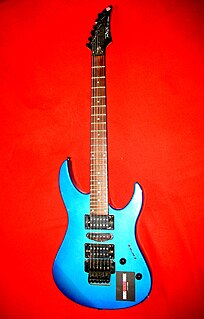
The Yamaha RGX and RGZ electric guitars Series are manufactured by the Yamaha Corporation and bear a close resemblance to the Ibanez RG series, the Jackson Soloist and other "superstrat" enhanced copies of the Fender Stratocaster. These Taiwan-made instruments were introduced in 1987.

The Ibanez GIO Series is an affordable guitar series produced by Hoshino Gakki (Ibanez), replacing the Cimar line. The GIO guitars are a "first step" model line, similar to Fender's Squier guitars, and Gibson's Epiphone line.
Fender California Series electric guitars were produced by Fender in 1997 and 1998. The guitars were carved in California, shipped to Baja California Norte, Ensenada, Mexico for painting, then assembled in California.
The Fender Prodigy is a discontinued model of electric guitar produced by Fender from 1991 to 1993. It is one of Fender's attempts to compete with the superstrat-style guitars produced by Ibanez, Jackson/Charvel, Carvin Corporation and Yamaha. Since the Prodigy series was discontinued after about two and half years of production without a clear reason, it is considered one of Fender's rare models because of its limited production. Fender also produced a Prodigy Bass based on the Precision Bass Plus Deluxe featuring a P/J pickup layout, 2-band active circuitry and a "fine-tuner" Schaller Elite bridge assembly.

Starcaster by Fender is a range of instruments and accessories aimed at students and beginners, marketed by the Fender Musical Instruments Corporation from the early 2000s until at least 2011. As of April 2018, no products were being marketed under this brand.
The Fender Elite Stratocaster is an electric solid body guitar that was manufactured by Fender in 1983 and 1984. The name was revived from 2016 to 2019 with the Fender American Elite Stratocaster Series.
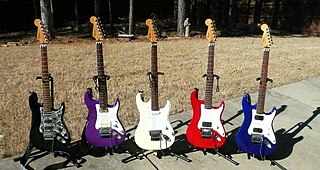
The Squier Stagemaster (discontinued) is a guitar made by Squier, which normally manufactures less expensive authorized copies of Fender's more popular guitars and bass guitars. The Stagemaster is similar in appearance to a Stratocaster with a few cosmetic and functional differences, and is typically classified as a Superstrat. Generally, these differences are:
The Yamaha Corporation is a multinational corporation and conglomerate based in Japan with a wide range of products and services, predominantly musical instruments, motorcycles, power sports equipment and electronics.
The Fender Telecaster, colloquially known as the Tele, is an electric guitar produced by Fender. Together with its sister model the Esquire, it is the world's first mass-produced, commercially successful solid-body electric guitar. Its simple yet effective design and revolutionary sound broke ground and set trends in electric guitar manufacturing and popular music.
Blade Guitars is a manufacturer of electric guitars and bass guitars founded by luthier Gary Levinson in 1987. Levinson had been repairing guitars since 1964 and, in 1977, during his graduate studies at the University of Basel, Switzerland, he founded Guitars by Levinson. Using the experience he gathered from his work, he decided to start Blade Guitars in 1985. By 1986, he was refining the idea of a line of guitars based on the concept he defines as "Classic Design, Creative Technology"; at this time, he was also determining the features that would characterize his range of guitars. In January 1987, a manufacturing deal was reached for the production of the guitars. Blade Guitars made their debut in October 1987, at the music show of Tokyo. Their presentation at the Frankfurt Musikmesse in 1988 signalled their European launch.
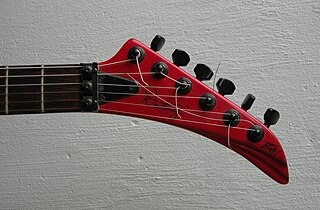
The Peavey Destiny is a solid body electric guitar of the superstrat type, manufactured between 1989 and 1994 in the US by Peavey.












